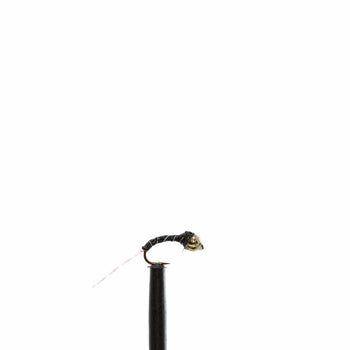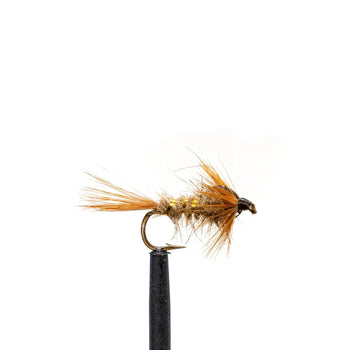Conquer Spring Runoff: Fly Fishing Tactics That Work

Spring is an exciting yet challenging time for fly anglers. As winter fades and warmer weather arrives, fish become more active and feeding increases. However, the annual snowmelt from high elevations leads to spring runoff, creating high, off-colored flows in rivers and streams. While these conditions may seem daunting, there are effective tactics to catch trout during this transition period.
Understanding Spring Runoff
Runoff happens when melting snow and ice rapidly enter waterways, causing levels to rise and currents to rage. The influx of cold, murky water can make locating and enticing trout extremely difficult. However, runoff also dislodges new food sources and gets the seasonal insect hatches going. Fish will be actively feeding if you can find them.
Tactics for Success
Spring runoff presents unique challenges but also exciting opportunities for fly anglers. The key to success lies in adapting your approach to the changing conditions. By selecting the right fly patterns, adjusting your techniques, and targeting the optimal spots, you can significantly improve your chances of a productive fishing trip during runoff.

Go with Bright Fly Patterns
During spring runoff, visibility in the water can be severely reduced due to muddy and turbulent flows. This makes it essential to use flies that stand out and attract the attention of trout. Bright, gaudy flies with tinsel ribbing are particularly effective in these conditions, as they can catch the eye of fish even in murky water. Among these, purple fly patterns are especially noteworthy for their success in off-colored conditions.
Tips for Using Bright Fly Patterns
-
Match the Conditions: Adjust the size and weight of your flies based on the water conditions. Heavier flies are better for deep, fast-moving water, while lighter flies work well in slower, shallower sections.
-
Use a Variety of Retrieves: Experiment with different retrieves to find what triggers strikes. Sometimes a slow, steady retrieve works best, while other times a fast, erratic movement can entice a bite.
-
Combine with Attractors: Pair your bright fly patterns with other attractor flies to create a multi-fly rig that maximizes visibility and appeal. For example, use a bright purple fly as the lead and a more natural pattern as the dropper.
By incorporating bright and gaudy fly patterns, particularly those in purple, into your spring runoff fishing strategy, you'll increase your chances of success. The high visibility, suggestive imitation of various insects, and unique appeal of these flies make them indispensable tools for any angler facing challenging runoff conditions.
Why Purple Flies Work So Well
There are several compelling reasons why purple flies are particularly effective during runoff:
-
High Visibility: The bold purple hue transmits well and remains visually striking, even in dingy or stained water. This high contrast makes it easier for trout to spot the fly amidst the murkiness, increasing your chances of a successful strike.
-
Suggestive Insect Imitation: Purple can effectively mimic the colors of various aquatic insects and prey items that trout feed on. Stonefly nymphs, certain mayfly species, caddis pupae, and even small sculpin or baitfish can have purple hues. This versatility allows purple flies to serve as a multi-purpose attractor in various fishing scenarios.
-
Unique Offering: Purple is not a commonly used color in many fly boxes, making it a novel and intriguing option for trout. The uniqueness of a purple fly can trigger reactionary strikes from fish that are accustomed to seeing more conventional, drab patterns. This element of surprise can be especially useful when fishing in heavily pressured waters.

Adjust Your Approach
Getting your flies down in the strike zone is critical, especially during spring runoff when fish tend to hold in deeper, slower-moving water. To ensure your flies reach these depths, consider the following adjustments:
-
Use Weighted Flies: Opt for beadhead, tungsten, or other weighted flies. These are specifically designed to sink quickly and stay in the strike zone longer. The added weight helps counteract the faster currents and gets your flies down where the fish are feeding.
-
Pair with a Sinking Leader: A sinking leader can be a game-changer. It helps your flies descend faster and stay submerged, increasing your chances of reaching deeper runs and troughs where trout often hold during high water.
-
Add Split Shot: When you need extra weight, add split shot to your leader. Place the split shot a few inches above your fly to help it sink more effectively. Adjust the amount of weight based on the depth and speed of the water you're fishing.
-
Mend Your Line: Proper mending is essential to avoid creating a belly in your line, which can lift your flies out of the strike zone. Mend upstream immediately after your cast to allow your flies to sink naturally. This technique keeps your presentation more natural and increases your chances of a successful hookup.
-
Adjust Your Casts: Shorten your casts to maintain better control and achieve a more accurate presentation. Long casts can result in too much slack or drag, preventing your flies from sinking properly.
By making these adjustments, you'll improve your fly's chances of reaching and staying in the strike zone, where trout are more likely to strike. Mastering these techniques will make your spring runoff fishing sessions more productive and enjoyable.
Target Soft Water
During high runoff events, trout seek refuge in areas with softer flows to conserve energy. Identifying and targeting these spots can significantly increase your chances of success. Here's how to effectively fish these soft water zones:
-
Inside Bends: Rivers often form inside bends where the current slows down and creates a calm pocket. These areas can be gold mines for trout during high runoff. Position yourself to cast upstream and let your flies drift naturally through these bends, giving them a chance to sink and entice feeding trout.
-
Back Eddies: Look for areas where the main current flows past an obstruction, creating a swirling back eddy. These spots can hold a surprising number of fish seeking respite from the strong current. Cast your fly into the slower-moving water and let it drift into the eddy, mimicking the natural movement of prey.
-
Undercut Banks: Undercut banks provide excellent cover and slower water, making them ideal hiding spots for trout. Approach these areas stealthily and present your fly close to the bank. The trout will often be lurking in the shadows, ready to ambush anything that comes their way.
-
Deep Buckets: Deep buckets or holes in the riverbed offer trout a place to rest out of the main current. These deeper sections can be found in various parts of the river, including the tail ends of pools. Use weighted flies to get down to these depths and keep your fly in the strike zone as long as possible.
-
Pockets: Small pockets of calm water behind rocks or other obstacles can hold trout during high flows. These micro-habitats provide a brief respite from the fast water, allowing trout to conserve energy. Make precise casts to these pockets, ensuring your fly lands softly to avoid spooking the fish.
-
Downsize Your Flies: During high runoff, trout may become more selective and less likely to chase large flies. Downsize your flies to better match the smaller insects being dislodged by the turbulent water. Smaller nymphs and emergers can be particularly effective in these conditions.
-
Thoroughly Fish the Edges: Don't overlook the edges of the river. Often, trout will be found right along the banks where the current is weaker. Fish these areas thoroughly, making multiple casts to cover the water methodically. Pay special attention to seams where fast and slow water meet, as trout will often hold in these transition zones.
By focusing on these soft water areas and adjusting your approach accordingly, you'll be able to find and catch more trout even during the challenging conditions of spring runoff. Understanding where trout seek refuge and how to present your flies effectively in these zones is key to a successful fishing trip.
Be Prepared to Move
Flexibility and mobility are key during the dynamic conditions of spring runoff. Here’s how to stay agile and increase your chances of finding productive fishing spots:
-
Stay Mobile: Be ready to change locations frequently. Water conditions can fluctuate dramatically from day to day or even hour to hour. A stretch of river that’s too high and fast in the morning might become more fishable by the afternoon if flows recede slightly. Keep your gear organized and light to facilitate quick moves.
-
Monitor Water Levels: Keep an eye on local water level gauges and weather forecasts. A small drop in water levels can transform previously unfishable areas into prime fishing spots. Conversely, rising water levels might push fish into new areas. Apps and websites that track river conditions in real-time can be invaluable tools for making informed decisions about where to fish.
-
Explore Tributaries: When main rivers are blown out and unfishable, turn your attention to tributaries. These smaller streams often clear up faster than larger rivers and can provide excellent fishing opportunities. Tributaries typically have less turbulent flows, making them ideal refuges for trout during high runoff.
-
Check Side Channels: Side channels can offer slower, clearer water when the main channel is raging. These offshoots of the main river can hold significant numbers of fish seeking shelter from the powerful currents. Explore these areas thoroughly, as they can be less pressured and more productive than the main river.
-
Fish Smaller Creeks: Smaller creeks and streams often maintain better clarity and manageable flow rates during runoff conditions. These smaller waters can be gems, providing solitude and the chance to catch fish that are less pressured. Downsizing your gear and tactics to match these smaller environments can lead to successful outings.
-
Observe Changes: Pay attention to subtle changes in the environment. Water that was chocolate-colored yesterday might have cleared significantly today, offering a new fishing opportunity. Similarly, areas that were barren can suddenly hold fish if conditions improve. Stay observant and be ready to capitalize on these shifts.
-
Adapt Your Strategy: Be willing to adapt your fishing strategy as you move. Different locations might require different techniques. For instance, nymphing might be effective in a deep pool in the morning, while dry fly fishing could become productive on a shaded stretch in the afternoon. Versatility in your approach will help you make the most of each spot you fish.
-
Stay Informed: Engage with local fishing reports, forums, and fellow anglers. They can provide valuable insights into current conditions and potential hotspots. Networking with other anglers can help you stay ahead of changing conditions and find the best fishing locations.
By staying prepared to move and being flexible in your approach, you'll be able to adapt to the ever-changing conditions of spring runoff. This mobility not only increases your chances of finding fishable water but also enhances your overall fishing experience by exposing you to new and varied fishing environments.
Effective Fly Patterns for Spring Runoff
To further enhance your success during spring runoff, consider these ten effective fly patterns and how to fish them:
 |
 |
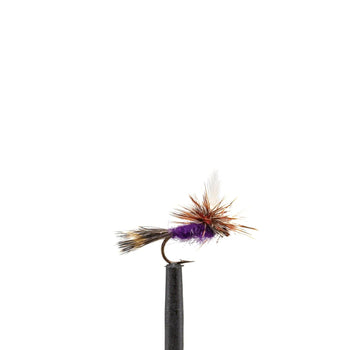 |
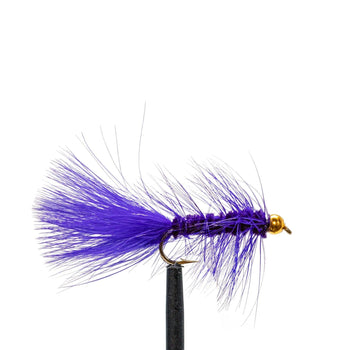 |
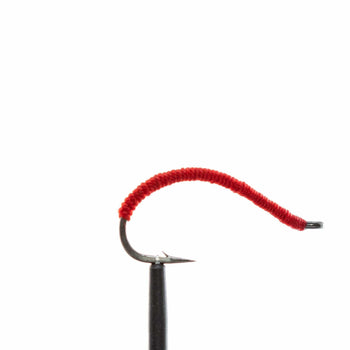 |
| Beadhead Purple Prince Nymph | Beadhead Flash Purple Prince Nymph | Purple Haze | Beadhead Purple Wooly Bugger | San Juan Worm |
-
Beadhead Purple Prince Nymph: The Beadhead Purple Prince Nymph is an excellent choice for murky water due to its high visibility and weight, which helps it sink quickly. Fish it through deeper runs and pockets using a nymph rig. Its beadhead ensures it gets down to the strike zone effectively, making it a reliable option during high runoff.
-
Beadhead Flash Purple Prince Nymph: This variation incorporates flashy materials to attract fish in low-light conditions. Drift it near the bottom to entice feeding trout. The added flash helps to grab the attention of trout in turbid waters, increasing your chances of a strike.
-
Purple Haze: The Purple Haze is a versatile dry fly that can be used during hatches. Its purple color stands out in stained water, making it easier for fish to spot. Fish it on the surface, allowing it to drift naturally with the current. This fly is particularly effective during mayfly hatches in runoff conditions.
-
Beadhead Purple Wooly Bugger: The Beadhead Purple Woolly Bugger is a highly effective streamer pattern. The beadhead adds weight, helping it sink quickly, while the purple color remains visible in turbid water. Use a slow, steady retrieve or strip it aggressively to provoke strikes. This fly can imitate a variety of prey, including baitfish and larger aquatic insects.
-
San Juan Worm: The San Juan Worm mimics earthworms dislodged by high water. Drift it near the bottom with a nymph rig, adding enough weight to get it down quickly. This simple yet effective pattern is a staple during spring runoff, as worms are a common food source during this time.
-
Egg Patterns: High runoff can wash eggs downstream, making them an easy meal for fish. Fish them under an indicator, allowing them to drift naturally in the current. Egg patterns are particularly effective in the early spring when fish are looking for high-protein meals.
-
Zebra Midge: The Zebra Midge is a small but effective pattern that mimics midge larvae. Fish it below an indicator or in a dropper rig, allowing it to drift naturally. Its simple design and effective coloration make it a go-to fly for spring runoff conditions.
-
Hare's Ear Nymph: The Hare's Ear Nymph is a classic pattern that imitates a variety of aquatic insects. Drift it naturally through runs and pools, adding occasional twitches. This versatile nymph works well in various water conditions, making it a reliable choice during runoff.
-
Purple Sparkle Worm: The Purple Sparkle Worm combines the visibility of the San Juan Worm with added flash. Drift it through slow-moving water and pools where trout are holding. The sparkle material helps to attract fish in murky conditions, increasing its effectiveness.
-
Purple Egg Sucking Leech Flame Head: The Purple Egg Sucking Leech Flame Head is an effective streamer for attracting aggressive strikes. Its combination of colors and movement makes it irresistible to trout. Fish it with a strip retrieve or let it drift in the current. This fly can imitate both leeches and larger aquatic prey, making it a versatile option during high runoff.
With some strategic adjustments and the right fly patterns, you can still catch trout during the runoff transition. Having the right flies like purples, getting your offerings down, and targeting softer lies are keys to success. Be safe, prepare for variable conditions, and enjoy the start of another incredible season!
SHOP OUR SPRING FLY COLLECTION
RELATED ARTICLES:
- Spring Fly Guide: Discover the Most Effective Patterns & Techniques
- Why Purple Fly Patterns Work So Well In Spring Runoff
- The Allure of the Purple Haze Dry-fly Family
- 5 Tips & 5 Flies For Early Spring Fly Fishing
- The Incredible Egg & Wondrous Worms
- Spring Fly Fishing Essentials



